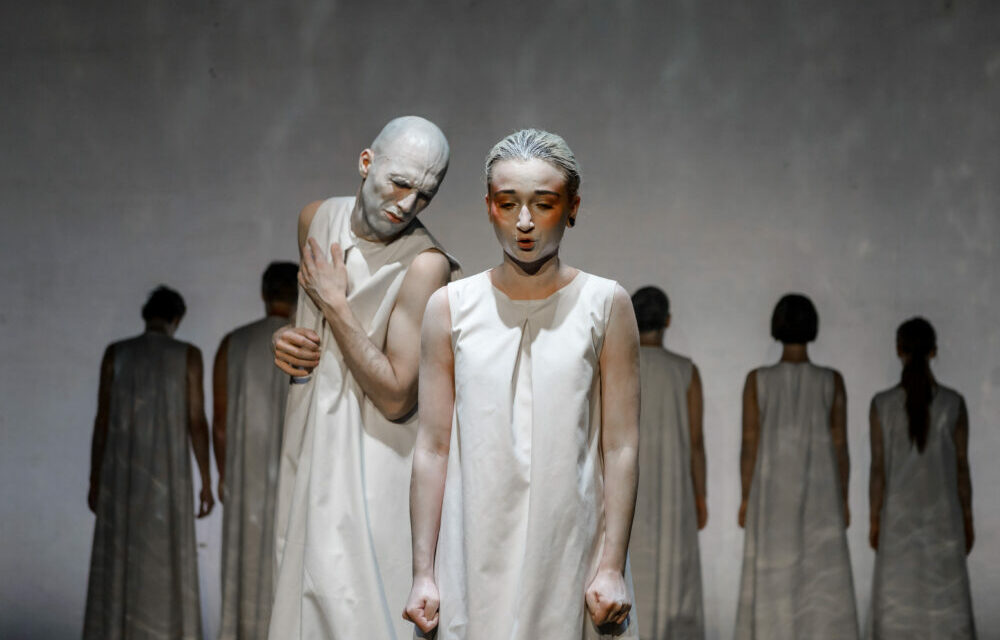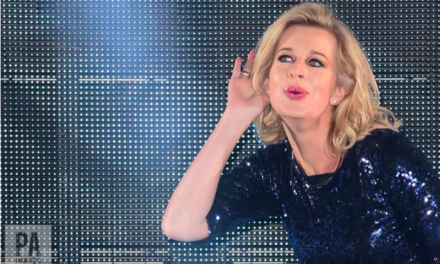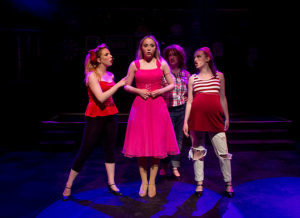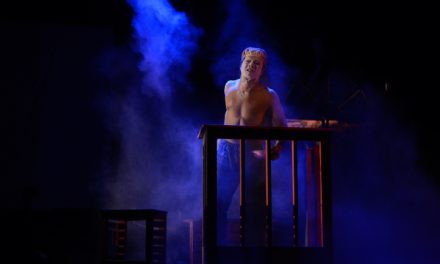The talented Romanian director Mihaela Panainte adapts Nobel laureate Herta Müller’s visceral first book for an intimate studio performance that capitalizes on the dynamic energy of a young and well-oiled ensemble, and explores corporality in a mesmerising installation that tests the boundaries of autobiographical writing in and for performance. By turning to an initially censored piece of literary fiction that is also rather economical with words, Panainte’s production celebrates the precision of carefully chosen words and theatrical images, and highlights the universality inherent in the source material, dismantling the illusion of innocence often associated with village life and defying nostalgic reminiscences of times and events past. Produced at the studio of the National Theatre in Iaşi, operating as a creative hub mainly for younger artists, this sell-out production has proven appeal to a remarkable cross-section of the local population, and is successfully enticing new audiences to contemporary experimental theatre-making that intersects the tradition of text-based drama with visual arts and forms of movement-based performance.
![<em>Ţinuturile joase</em> [<em>Lowlands </em>] Publicity poster. Photo: Odin Moise.](https://thetheatretimes.com/wp-content/uploads/2019/05/POSTER-651x1024.jpg)
Ţinuturile joase [Lowlands ] Publicity poster. Photo: Odin Moise.
As a German-speaking author writing in eighties Romania, Herta Müller conjures up the world of her childhood in the Swabian community of the Banat region, situated in the western part of the country, along the border with Serbia and Hungary. This is a frank and penetrating view of an isolated population, on the verge of dissolution due to ethnic cleansing achieved by accelerated immigration to Germany, perceived with reticence by some Banat-Swabians who found Müller’s portrayal of village life unsympathetic. Indeed, Müller makes no attempt at idealising this childhood or the climate in which it takes place; her aim is a declared exercise of free speech, which she also practised on a directly political level as a member of Aktionsgruppe Banat, a group of German-speaking writers in Romania who spoke up against censorship under Nicolae Ceaușescu’s dictatorial regime. Müller will return time and time again to this subject matter, most famously in the novel The Land of Green Plums, and will receive the 2009 Nobel Prize for depicting the ‘landscape of the dispossessed’ with ‘the concentration of poetry and the frankness of prose’.
It is this frankness and concentration of lyricism that Mihaela Panainte’s production succeeds in capturing most eloquently. Rather than privileging historical accuracy or the local flavour of a particular place, the director explores the philosophical notion of one’s relationship with childhood, childhood being seen here as a universally valid inner personal space that is at the root of our becoming as human beings. The variety of stories covering multiple aspects of daily life in the book are pulled together as a multiplicity of interconnected and overlaid theatrical images, that invite spectators into parallel worlds in a dream-like space where reality and illusion are situated side by side. The child protagonist at the centre of this universe is the ultimate observer of this world, and this observation is carried out in minute detail and signposted for the audience by way of a tight choreography that interweaves sight, sound, gesture, and movement. Taking into account ritualistic aspects of village life, such as the mother’s obsession with sweeping, the weekly family bath or the funeral sermon, the production confronts adult behaviour with the candid fear and curious imagination of a child observer, and as Panainte declares, this rural universe stands in for a cosmic universe, and her concern is with the transformative potential of the child protagonist. In this sense we are dealing with a process of initiation, given that the child is the only figure that shows indignation at troubling events and the only one who has the potential to engineer change by making use of creative imagination.
![<em>Ţinuturile joase</em> [<em>Lowlands </em>] Photo: Odin Moise.](https://thetheatretimes.com/wp-content/uploads/2019/05/Lowlands_fig-4-e1558382210166-1000x667.jpg)
Ţinuturile joase [Lowlands ] Photo: Odin Moise.
Fascinated by a sense of cyclical time, rather than its chronological counterpart, Panainte dramatizes emotional memory and braids snippets of seemingly fragmented action to foreground a stratification of history that in the director’s words is both ‘revelation’ and ‘concealment’ at the same time. Arguing that we can only find ourselves if we are able to return to our childhood, as a repository of potential resources and of revelations to come, Panainte has taken the directorial decision that all characters are mirror images of this child. This decision is motivated not by a desire to explore personal histories as such but by the endeavour to adopt a child’s perspective when it comes to engaging with the world and by addressing the impact of emotional and geographical distance from one’s homeland. Müller’s entire career is situated at the interface between two cultures and languages (German and Romanian), and Panainte herself was residing away from Romania at the time of conceiving the project.
![<em>Ţinuturile joase</em> [<em>Lowlands </em>] Photo: Odin Moise.](https://thetheatretimes.com/wp-content/uploads/2019/05/Lowlands_fig-2-e1558382152202-1000x668.jpg)
Ţinuturile joase [Lowlands ] Photo: Odin Moise.
The 7m by 7m stage is flooded with water approximately 10 cm deep, and surrounded by four tetrahedral columns in each corner. This minimalist space is the work of scenographer Dan Istrate, a trained sculptor whose main expertise is working in marble. It excels in juxtaposing lightness and fluidity with the material qualities of sculptural objects, as a visual counterpart to Müller’s lyrical text that offers a unique braid of extremely concrete details and deeply poetic images. As Istrate observes, his design was influenced by ‘the principle of mirroring, perceived as both a physical and educational phenomenon’. Drawing on the work of Gombrich, Istrate points out that we rarely tend to perceive mirrored images as optical illusion, and even though the reflected image undergoes transformations, we only notice these if involved in actual experimentation with the phenomenon. Thus, the reflection of the columns is temporarily disrupted as the actors keep moving about in the water, but it reappears time and time again once stillness sets in, or movement is directed to other areas of the set. For Istrate, childhood is a unique time when one’s personal mirror is being constructed, and the memory of childhood is that state of grace where we search for ourselves in reflection, attempting to come to terms with our own selves.
![Ţinuturile joase [Lowlands ] Photo: Odin Moise.](https://thetheatretimes.com/wp-content/uploads/2019/05/F4-1024x685.jpg)
Ţinuturile joase [Lowlands ] Photo: Odin Moise.
Nadirs – Lowlands – Shadowlands was performed at the Vasile Alecsandri National Theatre in Iaşi, Romania.
Adapted and directed by Mihaela Panainte
Scenography: Dan Istrate
Choreography: Oana Sandu
Cast: Mălina Lazăr, Ștefania Sandu, Horia Veriveș, Ionuț Cornilă, Andrei Grigore Sava, Radu Homiceanu, Alexandru Gușă, Sara Tayari, Marian Alexandru Chiculiță, Bogdan George Ionescu (drums)
This event was co-produced by the National Theatre in Iaşi, the German Cultural Centre in Iași and the Goethe Institute. In repertoire in the 2018–19 season.
This post was written by the author in their personal capacity.The opinions expressed in this article are the author’s own and do not reflect the view of The Theatre Times, their staff or collaborators.
This post was written by Jozefina Komporaly.
The views expressed here belong to the author and do not necessarily reflect our views and opinions.


















